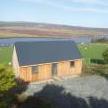Leaderboard
Popular Content
Showing content with the highest reputation on 08/07/16 in all areas
-
The self-builders guide to the construction phase. Thought I'd start a thread where we can comment on any books we have found of use. Kicking it off, I've just finished The Self-builder's guide to the construction phase by Vince Holden. I found it a good read and it has addressed to a degree something I've struggled to find elsewhere - namely a detailed breakdown of the order to do things on site - like scaffold lifts and avoiding unnecessary changes (and thus cost), who does what after who and so on. Certainly for someone of my knowledge level this is helpful and for some reason seems to be skirted around in other self build books I've read, who allude to it, but are short on the detail, which always stuck me as odd given how important it is if you do not know. This book definitely gives you a handle on that issue. It also deals nicely with some of what the various trades will want from you and from each other and who you need to have a 3 way conversation with if managing the build yourself. I've really enjoyed the read, and also available by Holden is his guide to project management, although I have not read that. The one down I have is that this paperback book is 294 pages, can be read in a day, but costs £24.95 at the time of writing. You can look at this one of two ways - either he's split what should be one book (600 pages would not be unreasonable at that price for a specialist subject) into two, meaning just short of £50 for both, or since you will save far more than £24.95 from even utilising one bit of the advice he gives, then it's good value.2 points
-
Ages ago I wrote a spreadsheet for doing what-if comparisons to see whether it was better to invest in more insulation in the walls, roof, floor, fit better windows and doors, or fit a better MVHR system. Others have found it useful and I've been reminded that I've not re-posted it over here, so here's the latest version. It should be self-explanatory, you fill in the cells with your wall, roof/ceiling and floor areas, add the areas of each door and window, put in the U values for each and, if you can, get hold of the met data from the met office for your area (the data in there is for West Wiltshire, right on the border with Dorset). This isn't a thorough modelling tool, it just looks at heat loss fairly accurately but doesn't take into account heat gains, although there is a crude way of doing that by drawing a line across the seasonal plot at the point where you don't use heating and you can very roughly assume that anything above that line will be heating. Please feel free to ask any questions, but bear in mind I wrote it back when I was designing our house and haven't used it for a couple of years. so I may be a bit rusty. Heat loss calculator - Master.xls [edited to add latest version of the spreadsheet]1 point
-
Having the ability to take a deep breath and not punch some idiot square in the nose is not taught in any book but it will come in handy in every build.1 point
-
My Dad bought a cheap Belle 240v one about 20yrs ago and it still looks almost good as new. Secret is to keep a bucket of shingle on hand and let it chew on that for ten minutes after you've finished. Definitely worth buying, and if you find it isn't being used stick it on Gumtree.1 point
-
I found the Housebuilder's Bible good as our first introduction to the whole subject I guess, but was disappointed by lack of detail (bear in mind this is simply my own opinion based on what I want from a book that declares itself to the "Bible" of self building) for the actual self builder and again a detailed explanation of the proper order if you are managing the project yourself. It is covered, but not in the way it is in The self-builders guide to the construction phase. Now the Building Construction Handbook and Building Services handbook I really love and these two books really deserve to call themselves the "Bible" of their specific areas (but don't). If you could read and absorb these two from cover to cover you'd truly be an expert. They are aimed both at the trade as reference and as course reference for building trade students. At £27.54 for 966 pages the Building Construction Handbook is just absolutely jam packed with technical drawings and information, and I really mean jam packed without a single word wasted. Because the books are a reference for builders and for students they take you from "this is a house" all the way to cross sections of every part of a building you can think of. Unfortunately Amazon don't have a "look inside" tab on this one so it's hard to get just how comprehensive and well laid out it is. They are not primarily written for self builders and are technical manuals really, but eminently readable in how they are written, even by me who once didn't know a noggin from a stud or a Wide Lady from an Empress ( they are names for slate sizes ) before getting these. I actually cannot recommend these books enough. The Building Services Handbook (£30.19 new) by the same publishers takes you in 756 pages from Water regulations through to things such as calculating drag on long sewer pipe runs, cross sections of how loos, taps and other systems work, water, supply, drains, gas, electricity, earthing, sprinkler systems and fire, wind and solar calculations and so on. Just for working out my sewer line run and inspection points that will satisfy BC this book has paid for itself. Similarly to the Building Construction Handbook it's used as a reference for experts and a course book for students, which sits nicely for us non expert self builders. Even if you are not doing the work yourself, I think having a proper understanding will let you deal with the trades far better and I think being able to drop in some of the technical language and appearing informed may also prevent you being taken for a ride in some cases! Amazon does feature a "look inside" on this one, so it's worth taking a look at the contents page.1 point
-
I asked for one as a birthday present (I got a new deer rifle for my birthday the year before so we may be officially rednecks I think!) and even before our build starts it's been really useful and we've made paths, a shed base, and odd bits and bobs like bedding in posts which I'd have mixed by hand and hurt myself doing (I have a prolapsed disc and live on Tramadol), so even if I'd paid for it, it would have more than repaid itself by now.1 point
-
A lift line is a phone connection for an elevator, very common when developers are building flats etc they ask because it's something that will need to be connected early on in the construction phase - long before any flats are built and ready for living in.1 point
-
Another vote for house builders bible, one of the most useful elements has to be the per m2 cost for almost every task involved in house building - updated yearly accurate pricing on materials and labour. I know people have used it to cost their entire project, I use it more to verify quote I get in are not ridiculous. The Vince Holden book does sound like exactly what I am looking for though, the order of when to do things is currently a major gap in my knowledge. Heading to Amazon now off the back of your recommendation - thanks!1 point
-
Good topic, thanks. One of the best known books in this area must be Mark Brinkley's "Housebuilders' Bible" which is now on something like the eleventh edition. My (tenth) edition has some editing problems, in that page numbers don't match the contents page, which is a bit annoying. I find it a useful reality injection to temper the ideas you pick up off Grand Designs. It's quite entertainingly written in places as well.1 point
-
No counterbattens under those? Quite a different wall buildup to me, bet it'll be cosy though! Did you chamfer the top edge of the battens? My windows are in by the way, looking good!1 point
-
I'd read that as well, although at £10.99 for a litre, I've quite happily gone with patination oil. Following this discussion, I've treated the leadwork. A light clean to remove debris, dust etc then a coating of oil. A couple of hours work at most. Before: After: Looks much, much better. Thanks for all the advice.1 point
-
a 1 in 40 drop is 25mm drop in a 1 metre run. To measure that, I have a standard 1 metre long level, and I tape a small bit of 2*1 timber to one end of the level, then set the pipe so the level reads level and you have a 1 in 40 fall. You won't get any droops or puddling at that fall. You can go to 1 in 80 if you are short on fall. Then you have to be more particular that you can't get droops in the pipe run.1 point
-
I work to 1:40 for foul water drain pipes and 1:100 for just water.1 point
-
I haven't run anywhere!! I ran a euchre league on line for years and am well aware everyone has differing opionions, and different ways of expressing themselves, it's good to hear all sides of debate and as stated earlier some want to acheive the best spec and some want to do the bare minimum. As for me I'm still not totally convinced as to what method I will choose to use, more research needed and as I get mor ,information I will come back here and ask questions, you are knowlegable people, I'm a baker I can help you on bakery products but as for house building I'm learning every day. So its all good listening to everyones opinions offers a wide choice of options!!!1 point
-
And there in a nut shell is the problem for any forum, members trying to convey the right tone in written form. It's not easy getting it right 100% of the time, and each of us will no doubt have caused offence or upset or been offended or upset ourselves in equal measure. We are after all, only human. I was chatting to a fellow self builder earlier tonight, discussing amongst other things how frustrating it can be researching build techniques online and there being so many different ways to do things, and so many different points of view, as it's only natural for members to make comments which validate their own choices. I've taken the view that there is no such thing as a silly question, as it such questions which end up generating thought provoking discussion and from time to time innovative solutions. I'm on my sixth build and still learning...1 point
-
Interesting debate. Yes a lot of people here think building a well insulated low energy house is a good idea. But I don't recall ever making anyone look like a fool for not agreeing. I recall one discussion on the old place where the poster was adamant he wanted to do just enough to comply with regs and no more. Some of us suggested he could do better and it wouldn't cost much to build to a better standard. He was adamant he just wanted to do the minimum. I don't recall him ever being made to look a fool or feel unwelcome.I certainly hope he didn't feel that was the case. It still amuses me that people will only buy an A+++ rated fridge, and then put it in a house with an EPC rating of F.1 point
-
So I've used it... Installed 7 years ago (Actis Tri-Iso 9) in a large extension. And have the data to prove that it doesn't work as described hence my comments being what they are. It has low/nil sound insulation, is pretty poor at heat insulation in the summer and it works 'OK' in the winter however some of that is down to the detailing in how I installed it and ensured that there were no gaps at all at the edges and every joint was double taped. The one I used was part of the legal / advertisement retraction and had the certificate revocation due to how it was calculated. The whole set of discussions (including all tests) is here http://www.lifespacedesign.co.uk/msc/Foil.pdf In my experience I wouldn't reuse it due to the issues I've had and now that I've lived with it and also read a LOT more than the sketchy data that was originally available.1 point





